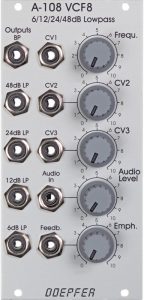Like the A-120, the A-108 filter is also based on the Moog transistor cascade, but uses not only 4 poles, but 8 and can therefore have a maximum slope of 48 dB. That sounds sensational at first, but in real synthesizer life it’s not that extremely spectacular. What is striking, however, is the fantastic and always very “musical” basic sound of the module – in all available filter modes. The filter modes are: bandpass, 6dB lowpass, 12dB lowpass, 24dB lowpass and 48dB lowpass. The 6 dB lowpass filter in particular can also create “the most delicately melting pad sounds” and would certainly be a highlight in any polyphonic synthesizer.
Otherwise, the module’s basic character is a filter for “classic” synthesizer sounds, which are reminiscent of Moog and can be driven very nicely into saturation (which accounts for a good part of the “vintage” sound), but which is clearly more versatile than the “originals”.
User interface
Inputs:
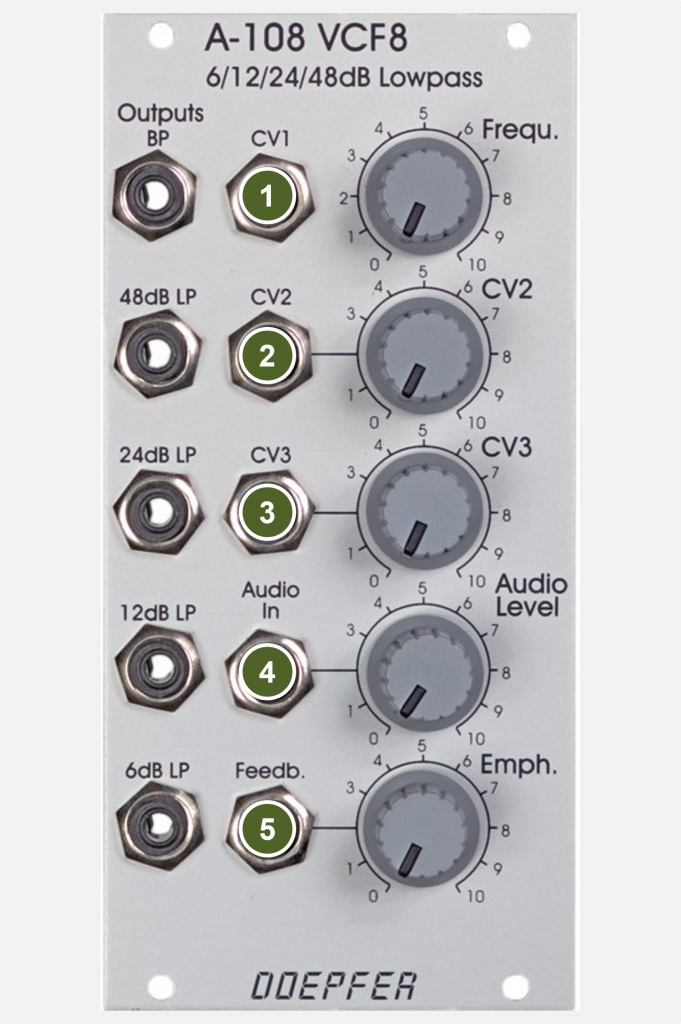
- CV1: Control voltage input for the cutoff-frequency (without attenuator).
- CV2: Control voltage input for the cutoff-frequency (with attenuator).
- CV3: Control voltage input for the cutoff-frequency (with attenuator).
- Audio In: Audio input.
- Feedb.: External input for the filter’s feedback path. As a standard for this, the output of the 48dB filter mode is connected here. This can be interrupted via the switching socket and replaced by another output.
Outputs:

- BP: Bandpass filter mode output.
- 48 dB LP: Output for the 48dB lowpass filter mode.
- 24 dB LP: Output for the 24dB lowpass filter mode.
- 12 dB LP: Output for the 12dB lowpass filter mode.
- 6 dB LP: Output for the 6dB lowpass filter mode.
Controls:
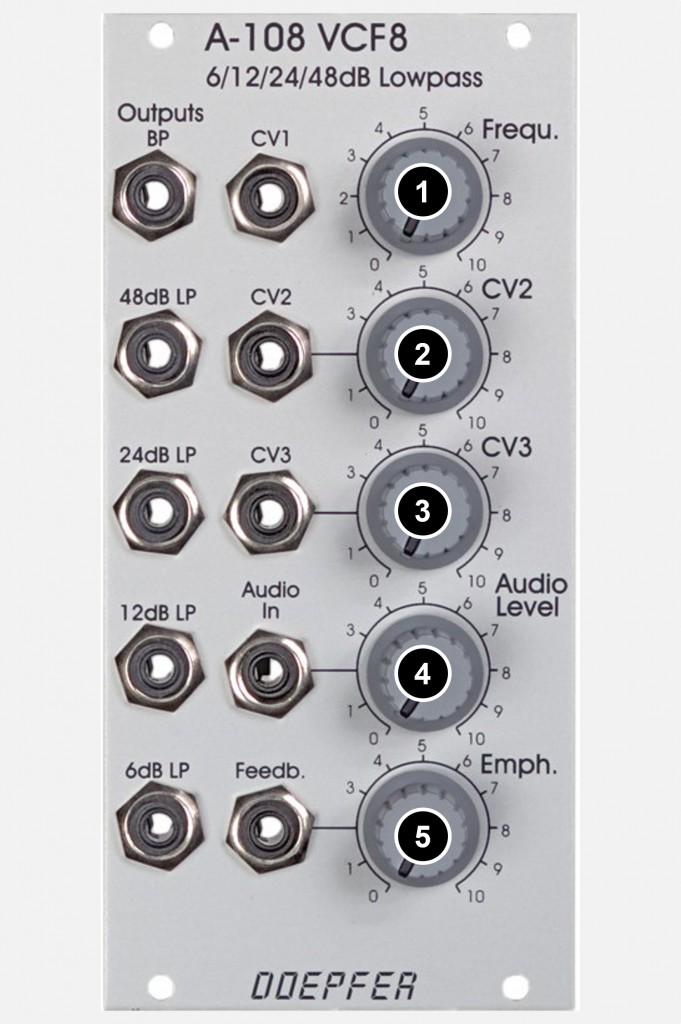
- Frequ.: Control for the cutoff-frequency, affects all filter modes.
- CV2: Attenuator for the control voltage input “CV2”.
- CV3: Attenuator for the control voltage input “CV3”.
- Audio Level: Attenuator for the audio input.
- Emph.: Control for the resonance of the filter.
Possible uses
Sort of like Moog…?
The A-108 is very good for anything that should sound “Moog-like”. When used as a 24dB, 12dB or 6dB filter, the outputs can be split and fed back into the feedback input – the 48dB output is switched there as standard. However, a 12 dB filter with 48 dB feedback doesn’t sound bad either – try it!
An obvious application is the mixing or crossfading of the different slope steepness. With a voltage-controlled mixer and the morphing controller, you can even achieve voltage-controlled edge steepness (similar to the morphing patch on the A-106-6).
Filters for BBDs
The 48 dB mode is also interesting for a completely different purpose: The high edge steepness can “surgically” cut off the frequencies that are caused, for example, by the internal oscillator of an analog delay (BBD Modules A-188-1 and A-188-2) with very long delays, without cutting off too much of the “useful signal”.
Voltage Controlled Resonance
Even if the filter itself does not have a control voltage input for the resonance, a voltage-controlled resonance can be implemented with the help of a VCA. The open feedback path of the module is used for this:
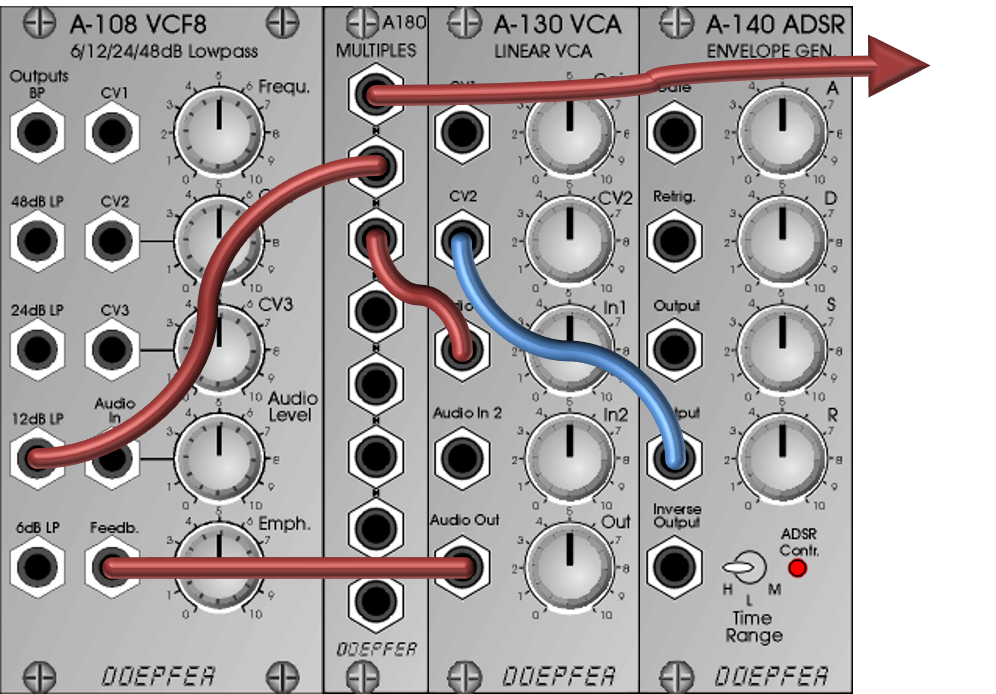
Configuration via the board
Other slope steepness via jumper
If required, the slope steepness of the individual outputs can be changed internally using jumpers. The second output (12 dB) can also be set to 18 dB, the third (24 dB) to 30 dB or 36 dB and the fourth (48 dB) to 42 dB if required.
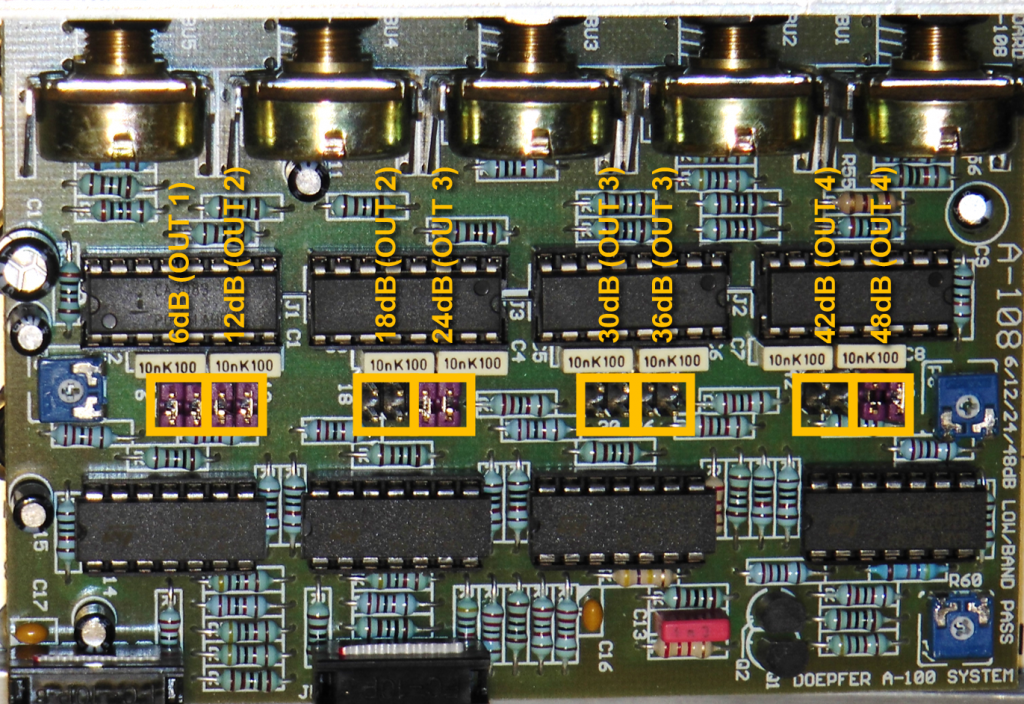
Sound examples
-
A-108 / Different edge steepness
The sound example again uses 3 A-110-1 VCOs as input signal (sawtooth, one VCO is transposed 1 octave down), I use filter key tracking and ADSR modulation of the A-108 filter with different intensities. The five different outputs of the A-108 can be heard as follows:
- 48 dB lowpass (from 0’00” and 4’05”),
- 24 dB lowpass (from 1’00” and 4’24”),
- 12 dB lowpass (from 1’42” and 5’00”),
- 6 dB lowpass (from 2’20” and 5’27”) and
- Bandpass filter (from 3’00” and 5’48”).
Every time I start without resonance (called “Emphasis” here, after all it is a Moog replica) and increase to full resonance. With the bandpass filter, the filter cutoff frequency is also changed manually. Then the same process is repeated, this time with the input level at maximum, to show the beautiful distortion. The VCOs are controlled by an A-155 sequencer.
Different edge steepness and the bandpass mode.
Technical specifications
| Width | 12 HP |
| Depth | 75 mm |
| Power requirements | 40 mA (+12V) / -40 mA (-12V) |
